| dc.contributor.author | Hausken, Kjell | |
| dc.contributor.author | Zhuang, Jun | |
| dc.date.accessioned | 2013-11-05T10:12:09Z | |
| dc.date.available | 2013-11-05T10:12:09Z | |
| dc.date.issued | 2011 | |
| dc.identifier.citation | Hausken, K. & Zhuang, J. (2011) Defending against a stockpiling terrorist. The Engineering Economist: A Journal Devoted to the Problems of Capital Investment, 56(4), pp. 321-353 | no_NO |
| dc.identifier.uri | http://hdl.handle.net/11250/184349 | |
| dc.description | This is an electronic version of an article published in Hausken, K. & Zhuang, J. (2011) Defending against a stockpiling terrorist. The Engineering Economist: A Journal Devoted to the Problems of Capital Investment, 56(4), pp. 321-353. The Engineering Economist is available online at: http://www.tandfonline.com/doi/abs/10.1080/00137916908928807#.UnjESBA2HZU. | no_NO |
| dc.description.abstract | A government defends against a terrorist who attacks repeatedly and
stockpiles its resources over time. The government defends an asset and
attacks the terrorist’s resources. The terrorist defends its resources and
attacks the government. We find four possible equilibrium solutions:
(1) the government attacks only, deterring the terrorist; (2) both players
defend and attack; (3) the government defends but does not attack, and
the terrorist attacks only; and (4) the terrorist attacks a passive government.
Understanding which factors impact the four cases is important in
order to combat terrorism. The terrorist allocates its resources over T periods
according to a geometric series with a stockpiling parameter. This
article analyzes how the government and terrorist prefer low versus high
stockpiling parameters and how these preferences interact with the other
parameters such as the terrorist’s resources and the players’ asset valuations,
unit defense and attack costs, and discount factors. If the terrorist’s
resources are small, it can be deterred in each period. If the terrorist’s resources
are extremely large, it allocates its resources equally across the T
periods, whereas the government prefers a single attack. If the terrorist’s
resources are intermediate, the terrorist would be deterred in each period
if it allocated its resources equally across the T periods. It thus strikes a
balance where it allocates much resources to early or late periods, to facilitate
attacks, and accept being deterred in the other periods. As the future
becomes less important, the terrorist attacks more in early periods. | no_NO |
| dc.language.iso | eng | no_NO |
| dc.publisher | Taylor & Francis | no_NO |
| dc.subject | defense | no_NO |
| dc.subject | attack | no_NO |
| dc.subject | terrorism | no_NO |
| dc.subject | terror | no_NO |
| dc.title | Defending against a stockpiling terrorist | no_NO |
| dc.type | Journal article | no_NO |
| dc.type | Peer reviewed | no_NO |
| dc.subject.nsi | VDP::Social science: 200::Political science and organizational theory: 240 | no_NO |
| dc.source.pagenumber | 321-353 | no_NO |
| dc.source.volume | 56 | no_NO |
| dc.source.journal | The Engineering Economist: A Journal Devoted to the Problems of Capital Investment | no_NO |
| dc.source.issue | 4 | no_NO |
| dc.identifier.doi | doi.org/10.1080/0013791X.2011.624260 | |
